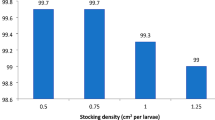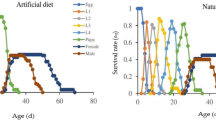Abstract
The growth of fishery and animal husbandry is being hindered by the scarcity of protein rich feed ingredients. Being rich in protein grasshoppers may be an alternative source of protein rich feed ingredients and hence rearing of these insects is essential for sustainable supply of insect biomass to the feed industry. The success of biomass production through insect rearing depends on the reproductive potentiality, rate of survival and growth of that particular insect. This study examines the biotic potential, fecundity, fertility, nymph mortality, life span and biomass production ability of a multivoltine grasshopper, Oxya hyla hyla (Serville, 1931) under semi-controlled condition. The grasshoppers are reared in 35 ± 2 °C temperature and 12L: 12D photoperiod and provided with food as fresh leaves of Cynodon dactylon (L.) Pers. to nymphs and Sorghum halepense (L.) Pers. to the adults. The result shows that a single pair of O. hyla hyla can lay on average 69.87 eggs in 4.96 ± 0.43 egg pods of which 7.37 ± 0.92 % eggs and 8.26 ± 0.99 % nymphs do not survive. The remaining survived nymphs metamorphose to 27.8 ± 3.35 male and 32.6 ± 3.21 female adults which produce a biomass of 18.48 ± 1.67 g wet weight. Thus a mass scale rearing of this insect may produce good amount of insect biomass which may be usable for fish and animal feed.

Similar content being viewed by others
References
Anand, H., A. Ganguly, and P. Haldar. 2008. Potential value of acridids as high protein supplement for poultry feed. International Journal of Poultry Science 7(7): 722–725.
Blanford, S., and M.B. Thomas. 2000. Thermal behavior of two acridid species: Effect of habitat and season on body temperature and potential impact on bio-control with pathogens. Environmental Entomology 29: 1060–1069.
Das, M., A. Ganguly, and P. Haldar. 2012. Determination of optimum temperature and photoperiod for mass production of Oxya hyla hyla (Serville). Turkish Journal of Zoology 36(3): 329–339.
Das, M., and D.C. Ray. 2013. An alternative host preference study of Oxya hyla hyla (Orthoptera: Acrididae): A non-insecticidal method of pest management. Indian Journal of Applied Research 6: 315–316.
DeFoliart, G.R. 1999. Insects as food: Why the Western attitude is important. Annual Review of Entomology 44: 21–50.
DeFoliart, G.R., M.D. Finke, and M.L. Sunde. 1982. Potential value of the Mormon cricket (Orthoptera: Tettigoniidae) harvested as a high-protein feed for poultry. Journal of Economic Entomology 75: 848–852.
Ganguly, A., R. Chakravorty, M. Das, M. Gupta, D.K. Mandal, P. Haldar, J. Ramos Elorduy, and J.M. Pino Moreno. 2013. A preliminary study on the estimation of nutrients and anti-nutrients in Oedaleus abruptus (Thunberg) (Orthoptera: Acrididae). Journal of Nutrition and Metabolism 5(3): 50–65.
Ganguly, A., R. Chakravorty, M. Das, M. Gupta, D.K. Mandal, P. Haldar, J. Ramos Elorduy, and J.M. Pino Moreno. 2014. A preliminary study on Oxya fuscovittata (marschall) as an alternative nutrient supplement in the diets of Poecilia sphenops (Valenciennes). PLoS One 9(11): e111848. doi:10.1371/journal.pone.0111848.
Ghosh, S., P. Haldar, and D.K. Mandal. 2014. Suitable food plants for mass rearing of the short-horn grasshopper, Oxya hyla hyla (Orthoptera: Acrididae). European Journal of Entomology 111(3): 448–452. doi:10.14411/eje.2014.038.
Haldar, P., A. Das, and R.K. Gupta. 1998. A laboratory based study on farming of an Indian grasshopper Oxya fuscovittata (Marschall) (Orthoptera: Acrididae). Journal of Orthopteran Research 8: 93–97.
Hinks, C.F., and M.A. Erlandson. 1994. Rearing of grasshoppers and locusts: Review, rationale and update. Journal of Orthopteran Research 3: 1–10.
Miura, K., and N. Ohsaki. 2004. Diet mixing and its effect on polyphagous grasshopper nymphs. Ecological Research 19: 269–274.
Nagagaki, B.J., and G.R. DeFoliart. 1991. Comparison of diets for mass rearing Acheta domestica (Orthoptera: Gryllidae) as a novelty food and comparison of food conversion efficiency with values reported for livestock. Journal of Economic Entomology 84: 891–896.
Nath, S., and P. Haldar. 1992. Effect of food on the reproductive potential of a common Indian grasshopper. Environment and Ecology 11(2): 450–452.
Olfert, O., C.F. Hinks, and N.D. Westcott. 1990. Analysis of the factors contributing to the biotic potential of grasshoppers (Orthoptera: Acrididae) reared on different cereal cultivars in the laboratory and in the field. Journal of Agricultural Entomology 7: 275–282.
Ramos-Elorduy, J. 2008. Energy supplied by edible insects from Mexico and their nutritional and ecological importance. Ecology of Food and Nutrition 47: 280–297.
Ramos-Elorduy, J., J.M. Pino, F. Rincon, C. Marquez, E. Escamilla, and M. Alvarado. 1984. Protein content of some edible insect in Mexico. Journal of Ethnobiology 4: 61–72.
Ramos-Elorduy, J., J.M. Pino, E.E. Prado, M.A. Perez, J.L. Otero, and O.L. Guevara. 1997. Nutritional value of edible insects from the State of Oaxaca, Mexico. Journal of Food Composition and Analysis 10: 142–157.
Ueckert, D.N., S.P. Yang, and R.C. Albin. 1972. Biological value in the desert grasshopper Taeniopoda eques. Journal of Animal Ecology 57: 369–389.
Uvarov, B.P. 1966. A handbook of general acridology. Cambridge: Cambridge University Press.
Wang, D., S.W. Zhai, C.X. Zhang, Q. Zhang, and H. Chen. 2007. Nutritional value of the Chinese grasshopper, Acrida cinerea (Thunberg) for broiler. Animal Feed Science and Technology 135(1–2): 66–74.
Whitman, D.W. 1998. Function and evolution of thermoregulation of rangeland grasshoppers as a protein concentrate. Ecological Entomology 65: 1286–1288.
Acknowledgments
Authors are thankful to the Head, Department of Zoology, Visva-Bharati University for providing all necessary laboratory and infrastructural facilities and to the University Grants Commission, New Delhi for providing financial assistance in the form of Major Research Project [F. No. 40-358/2011(SR)].
Author information
Authors and Affiliations
Corresponding author
Ethics declarations
Conflict of interest
None.
Rights and permissions
About this article
Cite this article
Ghosh, S., Haldar, P. & Mandal, D.K. Biotic Potential of a Short-Horned Grasshopper, Oxya hyla hyla Serville (Orthoptera: Acrididae) to Assess Its Biomass Producing Capacity. Proc Zool Soc 70, 46–51 (2017). https://doi.org/10.1007/s12595-015-0159-2
Received:
Revised:
Accepted:
Published:
Issue Date:
DOI: https://doi.org/10.1007/s12595-015-0159-2




